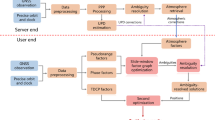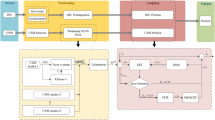Abstract
Effective indoor localization largely relies on the fingerprint database (model) of Received Signal Strength (RSS) in connection with Radio Frequency sources, such as the most widely used Bluetooth Low Energy (BLE) iBeacons. RSSs exhibit significant random variations in both the spatial and temporal domains. It is a notoriously onerous and challenging task to construct the fingerprint database for accurate localization, as the BLE RSSs must be captured via a full space scan from one point to another every few meters in a certain period of time. In order to tackle this problem, this study proposes an approach to fast fingerprints construction that only requires a sparse sampling of RSS of the space. First, a smartphone records the time series of RSS over a designated path, and a radio map for the path is then generated by a spatio-temporal mapping method using the Pedestrian Dead Reckoning algorithm. Second, the radio map of the entire space can be obtained via Gauss Process Regression (GPR), with outliers reduced to improve the reliability of the fingerprint database. Experiments have been performed in an underground carpark (38 m \(\times \) 14 m), and the experimental results indicate that the proposed approach can construct the fingerprint database 300% faster than the conventional approach does. The localization accuracy of both approaches is quite similar (80% error in 2.8 m). The proposed approach offers potential for the construction of a large-scale fingerprint database for a wide-area Location Based Service (LBS) of Smart City indoor and outdoor integration, where big RSS data processing is a must.












Similar content being viewed by others
References
Bahl P, Padmanabhan VN (2000) Radar: an in-building rf-based user location and tracking system. In: INFOCOM 2000. Nineteenth annual joint conference of the IEEE computer and communications societies. Proceedings. IEEE, vol 2, pp 775–784
Chen D, Hu Y, Wang L, Zomaya AY, Li X (2017) H-parafac: hierarchical parallel factor analysis of multidimensional big data. IEEE Trans Parallel Distrib Syst 28(4):1091–1104
Chen D, Li X, Wang L, Khan SU, Wang J, Zeng K, Cai C (2015) Fast and scalable multi-way analysis of massive neural data. IEEE Trans Comput 64(3):707–719
De S, Chowdhary S, Shirke A, Lo YL, Kravets R, Sundaram H (2017) Finding by counting: a probabilistic packet count model for indoor localization in ble environments. arXiv preprint arXiv:1708.08144
Faragher R, Harle R (2015) Location fingerprinting with bluetooth low energy beacons. IEEE J Sel Areas Commun 33(11):2418–2428
Harle R (2013) A survey of indoor inertial positioning systems for pedestrians. IEEE Commun Surv Tutor 15(3):1281–1293
Jung S, Lee Co, Han D (2011) Wi-fi fingerprint-based approaches following log-distance path loss model for indoor positioning. In: 2011 IEEE MTT-S international microwave workshop series on intelligent radio for future personal terminals (IMWS-IRFPT), IEEE, pp 1–2
Ke H, Chen D, Shah T, Liu X, Zhang X, Zhang L, Li X (2018) Cloud-aided online EEG classification system for brain healthcare: a case study of depression evaluation with a lightweight CNN. Softw Pract Exp. https://doi.org/10.1002/spe.2668
Kumar S, Hegde RM, Trigoni N (2016) Gaussian process regression for fingerprinting based localization. Ad Hoc Netw 51:1–10
Lee-Fang Ang J, Lee WK, Ooi BY, Wei-Min Ooi T, Hwang SO (2018) Pedestrian dead reckoning with correction points for indoor positioning and wi-fi fingerprint mapping. J Int Fuzzy Syst 1(Preprint):1–8
Li C, Xu Q, Gong Z, Zheng R (2017) Turf: fast data collection for fingerprint-based indoor localization. In: 2017 international conference on indoor positioning and indoor navigation (IPIN), IEEE, pp 1–8
Liu HH (2017) The quick radio fingerprint collection method for a wifi-based indoor positioning system. Mob Netw Appl 22(1):61–71
Liu HH, Liao CW, Lo WH (2015) The fast collection of radio fingerprint for wifi-based indoor positioning system. In: 2015 11th international conference on heterogeneous networking for quality, reliability, security and robustness (QSHINE), IEEE, pp 427–432
Liu HH, Liu C (2017) Implementation of wi-fi signal sampling on an android smartphone for indoor positioning systems. Sensors 18(1):3
Luo C, Hong H, Chan MC (2014) Piloc: a self-calibrating participatory indoor localization system. In: IPSN-14 proceedings of the 13th international symposium on information processing in sensor networks, IEEE, pp 143–153
Luo C, Hong H, Chan MC, Li J, Zhang X, Ming Z (2018) Mpiloc: self-calibrating multi-floor indoor localization exploiting participatory sensing. IEEE Trans Mob Comput 17(1):141–154
Ma L, Fan Y, Xu Y, Cui Y (2017) Pedestrian dead reckoning trajectory matching method for radio map crowdsourcing building in wifi indoor positioning system. In: 2017 IEEE international conference on communications (ICC), IEEE, pp 1–6
Mazuelas S, Bahillo A, Lorenzo RM, Fernandez P, Lago FA, Garcia E, Blas J, Abril EJ (2009) Robust indoor positioning provided by real-time rssi values in unmodified wlan networks. IEEE J Sel Top Signal Process 3(5):821–831
Mirowski P, Ho TK, Yi S, MacDonald M (2013) Signalslam: simultaneous localization and mapping with mixed wifi, bluetooth, lte and magnetic signals. In: 2013 international conference on indoor positioning and indoor navigation (IPIN), IEEE, pp 1–10
Peng Y, Fan W, Dong X, Zhang X (2016) An iterative weighted knn (iw-knn) based indoor localization method in bluetooth low energy (ble) environment. In: 2016 Intl IEEE conferences ubiquitous intelligence & computing, advanced and trusted computing, scalable computing and communications, cloud and big data computing, internet of people, and smart world congress (UIC/ATC/ScalCom/CBDCom/IoP/SmartWorld), IEEE, pp 794–800
Radhakrishnan M, Misra A, Balan RK, Lee Y (2015) Smartphones and ble services: empirical insights. In: 2015 IEEE 12th international conference on mobile ad hoc and sensor systems (MASS), IEEE, pp 226–234
Rai A, Chintalapudi KK, Padmanabhan VN, Sen R (2012) Zee: zero-effort crowdsourcing for indoor localization. In: Proceedings of the 18th annual international conference on Mobile computing and networking, ACM, pp 293–304
Tang Y, Chen D, Wang L, Zomaya AY, Chen J, Liu H (2018) Bayesian tensor factorization for multi-way analysis of multi-dimensional eeg. Neurocomputing 318:162–174
Yang S, Dessai P, Verma M, Gerla M (2013) Freeloc: calibration-free crowdsourced indoor localization. In: 2013 proceedings IEEE INFOCOM, IEEE, pp 2481–2489
Zhou M, Jin X, Li L, Tian Z, Ren H, Cong H (2018) Fast fingerprint database construction method in bluetooth indoor positioning system. In: Proceedings of the 11th EAI international conference on mobile multimedia communications, ICST (Institute for Computer Sciences, Social-Informatics and Telecommunications Engineering), pp 264–273
Zhuang Y, Syed Z, Li Y, El-Sheimy N (2016) Evaluation of two wifi positioning systems based on autonomous crowdsourcing of handheld devices for indoor navigation. IEEE Trans Mob Comput 15(8):1982–1995
Zhuang Y, Yang J, Li Y, Qi L, El-Sheimy N (2016) Smartphone-based indoor localization with bluetooth low energy beacons. Sensors 16(5):596
Zuo J, Liu S, Xia H, Qiao Y (2018) Multi-phase fingerprint map based on interpolation for indoor localization using ibeacons. IEEE Sens J 18(8):3351–3359
Acknowledgements
This work is partially supported by The National Key Research and Development Program of China (2016YFB0502201).
Author information
Authors and Affiliations
Corresponding author
Additional information
Publisher's Note
Springer Nature remains neutral with regard to jurisdictional claims in published maps and institutional affiliations.
Rights and permissions
About this article
Cite this article
Ai, H., Tang, K., Huang, W. et al. Fast fingerprints construction via GPR of high spatial-temporal resolution with sparse RSS sampling in indoor localization. Computing 102, 781–794 (2020). https://doi.org/10.1007/s00607-019-00724-5
Received:
Accepted:
Published:
Issue Date:
DOI: https://doi.org/10.1007/s00607-019-00724-5
Keywords
- Fingerprint database
- Received signal strength
- Time series
- Gauss process regression
- Spatio-temporal mapping
- Indoor localization




